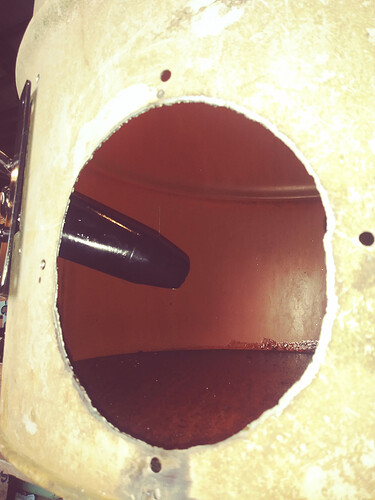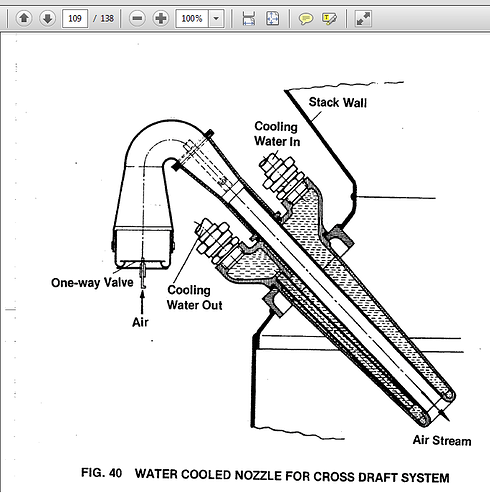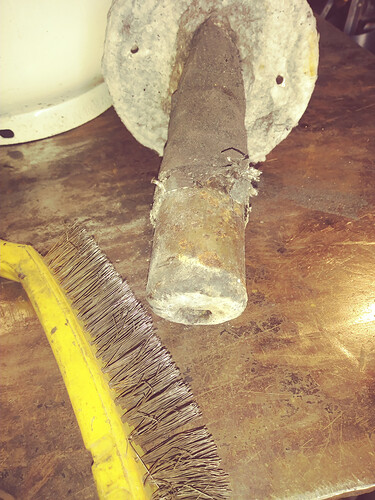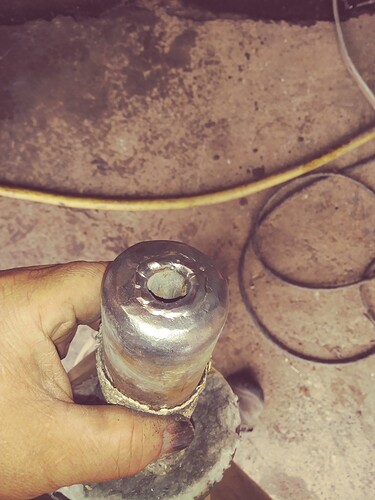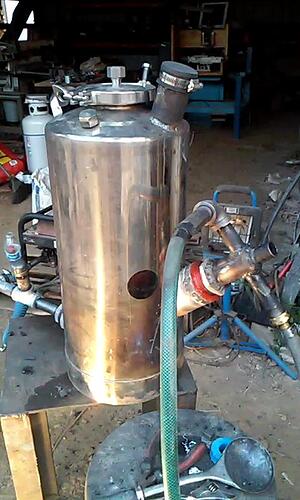Is this a crossdraft or downdraft?
Good works you are doing ChuckW.
The other thing about PNW wetside is although we don’t need the heat the really cold, cold folk do . . . we need a lot of days heating to keep our shops from internally sweating and rusting.
And boots, socks, raingear and wet dogs drying.
Your nozzle system CHP’s the heat for that.
Plus I like hot strong black teas. You are making the boiling hot water.
Regards
Steve Unruh
Sort of an updraft really. Nozzle points down a little, but the exit is at the top. Pretty much a direct copy of that WW2 gasifier (which I will now have to find the source material for)

**A grate is too much hassle, parts to make and break.
**The updraft preheats the descending fuel for a small efficiency boost.
**The clinker is always in the same place, just beneath the nozzle but never blocking it.
**The angled nozzle prevents descending fuel from choking air flow (important for small engines).
**The fuel bed surrounds the nozzle/fire zone and insulates it very well.
**Ash and dust settle somewhat into the fuel bed beneath the nozzle which you then remove partially with the clinker and screen for re-use.
Pretty well thought out design I thought (so I copied it  ). Very appropriate to small engines.
). Very appropriate to small engines.
http://www.driveonwood.com/library/pegasus-gasifier/
Pg 109 of the ‘Pegasus’ document has this photo:
Perhaps what I copied, doesn’t seem right though…
Chuck from Sandy, Oregon
PNAAV703 document on gasification
Nope, it was page 74-75 (pdf page numbers) of this document. I didn’t see this in the Library… did I miss it?
I took especially close note of the information on pg 79- 80 about blast velocity and the implications about gas quality, lack of classic reduction zones, and the simplification provided by ignoring grates and reduction zones.
It’s all mashed together in my unreliable memory. 
Chuck from Sandy, Oregon
I bet that downward angle helps to get that last bit of char.
So just by looking at it you’ve added a “simple” water jacket with two nipples for water in and out? No baffling or whatever to make the water dwell longer in the jacket?
Hi ChuckW,
No you did not miss this in the DOW library. It is not there. I’ve heard partial references to this publication but never a link to a clean copy. Thanks much for this.
Hopefully DOW Administrator Chris Seanz will be able to add this to the library.
I think your nozzle design is very close to what had been used successfully. Compare here:
And your links to the Making Charcoal topic about flame capping are original to the DOW too.
Best Regards
Steve unruh
How heavy was the thickness of the water jacket?
I’m just trying to get an idea for how I should do this on a Svedlund type central nozzle downdraft.
Hey SteveU, glad to add something to the library!
After looking at all those drawings, it looks like a sorta-suedo copy of a lot of things!
It’s all been done before, eh?
Chuck from Sandy, Oregon
Hey Cody, the nozzle I made started with a 2" pipe with .095 wall. The inner pipe is half inch ID, so probably 3/4" OD. The water space is whatever fits between them when nested.
You’ll notice the 2" pipe is ‘smashed’ flat at the flange until it touches the inner pipe. The oblong shape is ideal for locating the input and output pipes. Reducing the outer pipe to meet the inner also segregates the hot and cold flow somewhat so the coolant is encouraged to flow toward the hot end of the nozzle before rising through the outlet.
Chuck from Sandy, Oregon
I don’t think the shape is terribly important. The heat carrying capacity of water/coolant is very high. Here is an earlier design with a square end. It worked well but the increased surface area facing the fire caused it to absorb significantly more heat.
The blunt end protected the nozzle opening from fuel blockage, however, and allowed very low turn down on a tiny gasifier.
Note the eroded exhaust manifold wrap material I used to insulate it somewhat.
Chuck from Sandy, Oregon
Hi Steve,
I have this in my library long time already, might have even other books you ain’t seen yet.
https://drive.google.com/drive/folders/1n0wVBGR-nrxQcFPMplYQlJ2NSBiL4_DH?usp=sharing
Enjoy
Hi Chuck,
Wow a fellow reader / builder, thumbs up…
I ain’t been reading / following up on your posts yet, but keep it coming, eventually i catch up…
Thanks for sharing your experiences
Thanks Koen, I’ve been absorbing your work for years. Yikes! That’s a lot of reading material in your drive! Lol!
You have very good conversion numbers on your gasifiers (.4kg/kwhr), I’ve wondered for awhile now if the liquid cooled nozzles would seriously affect that. It is removing a lot of heat…
The whole goal was to have dead reliable nozzles you never had to worry about. But if that can be achieved without the complexity or heat penalty…
Chuck from Sandy, Oregon
I think a liquid cooled nozzle would really only affect the tip of the nozzle helping it to last longer not sure about it affecting the gas quality that much at all , dead reliable nozzles i think is every charcoaler’s dream .
Dave
As I’ve watched these threads develope, I’ve been wondering where liquid cooled nozzles fit on the spectrum of things. Obviously greater complexity… but;
**no exotic materials
**I probably only have 50 hours on my nozzles, but they give every indication of lasting a very long time
**you can bang one together in an hour
**??
But, there is KristijanL’s ‘flute’, various ceramics, various exotic metals, (and whoever else’s solution I’m forgetting). So many options…
Chuck from Sandy, Oregon
Hi Chuck , as long as i have spare nozzle then yes it takes as long as it takes to tip a 55 gallon drum on its side to take out a nozzle and refit with a new one .
I have tried so many types over the years now and we seem to be at a point now where maybe 3 types ( so far ) have out lasted the hundreds of hours and thousands of miles test and i for one am looking forward to someone coming up with the ultimate holy grail of nozzles that will put what we have at the moment in the shadows as too run and wear times , but i think we will always have to treat the nozzle as a replaceable consumable item , for the USA folk that means spending $15 whole bucks on something that for me so far has lasted over 2 years with no special care taken to cool it down at all , but even so that will not stop me trying new and wonderful ideas because that’s the tinkerer in me , the old if it aint broke dont fix it method sometimes has to go out the window to make a better one for the next build .
Dave
Hi Chuck
Good clean looking nozzle! Of all the water cooled stuff this one l like most.
I am sure it costs the gas quality a few crumbles from less efficiancy but on a expense of reliability. Looking good.
But a quote from SteveU l like most, “heat (energy) is only wasted if you waste it.”
You sparked a solution that l rolled trugh my head a some days now.
More on that later!
Edit oh, l forgot. In this application of yours it might be beneficial to use stainless steel. Lower heat conductivity, less losses. Just a thod.
That’s a nice looking gasifier Chuck. I’d like to see some more about that. I saw a video of your forge you sell. I’m going to have to steal that idea of the fluted air feed if I ever get back to pounding steel. Very nice. I’m wondering if you have some sort of check valve on the water jacket nozzle so that the heat expanded water can only move in one direction.
Hey Tom,
I didn’t try any kind of check valve. The thermosyphon seemed to work really well. I think if you let the hot coolant leave as vertically as possible for a foot or two with as little obstruction as possible, you will always have reliable flow. With good flow design, the hotter it gets, the better the flow.
When my five gallon coolant tank gets to boiling hot, the circulation is pretty vigorous, probably because it is making tiny bubbles of steam. But it was always stable, no steam locking or total evacuation type events.
“steel” away on the forge valve! (pun intended) 
Did you notice it is almost exactly like KristijanL’s ‘flute’ nozzle? I didn’t get it from him, but we arrived at the same place. It’s kind of a wrapped Pendrick plate I guess.
Kristijan, stainless would be a natural next step, eh? The mild steel held up so well it hasn’t been a priority to try it. Perhaps you’d gain a little efficiency AND longevity. And we’re back to cost and convenience… 
edit: my gasifier designs have evolved around the trouble spots; nozzles, doors, and filters. I took SteveU’s advice and went with six inch doors (highly recommend), Matt’s advice and used flat plate, tried to solve the nozzle problem with liquid cooling, and the filters, well, still working on that. I’ll put the gasifier in an appropriate thread.
Oh, and don’t forget about fuel production. Biggest trouble spot of all.
Chuck from Sandy, Oregon
There is quite a bit of cross pollination between forges, blast furnaces, gasifiers, etc.
The liquid cooled side draft tuyere is/was very common:
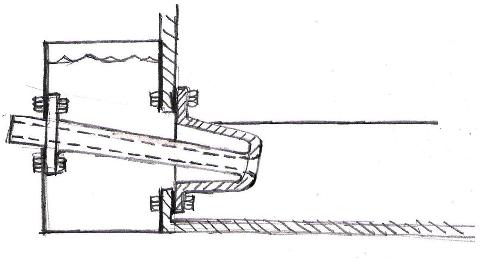
liquid cooled forge nozzle with natural flow
liquid cooled tuyere
Liquid cooled copper tuyere for blast furnace
Chuck from Sandy, Oregon
